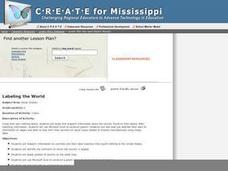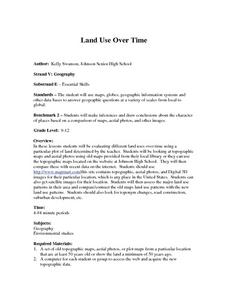Curated OER
Discovering Your Community
Students focus on the origins of the families that make up their community by exploring their family's origins through themselves, parents, and grandparents. Students create a map marked with family origins for the class.
Curated OER
Canada, Our Neighbor to the North
Students obtain knowledge of Canadian geography and history. Students work in groups gathering information to create a brochure on Canada. Students discover how French and British history helped shape Canada as a nation.
Curated OER
Japan: Yesterday and Today
Students study the geography and culture of Japan and discover important historical events. They look at the religions of Japan. They determine similarities and differences in the lives of teenagers in Japan and the US. They read and...
Curated OER
"Go West, Young Man!"
Students examine reasons why people migrated west. They describe how the geography of the U.S. changed in the 19 th century and design a PowerPoint presentation to convey factors for westward expansion.
Curated OER
Trading Traditions: Based on the American Samoa Quarter Reverse
Students investigate U.S. Currency by researching American Samoa. In this monetary unit lesson, students define the reverse and obverse of a coin while completing a currency related worksheet. Students identify American Samoa on a...
Curated OER
European Explorers of North and South America
Sixth graders explore the connection between the geography of America and the migration of the Native Americans to the American continents to the future conquering of the continents by the Europeans. They discuss the causes and effects...
Curated OER
Communicate with a Truck Driver
Sixth graders explore the life of a truck driver. In this transportation lesson plan, 6th graders map the route that a truck driver may take, communicate with a truck driver, and explore anticipated delivery time of goods that travel on...
Curated OER
Labeling the World
Sixth graders conduct research on the countries found on the labels on their clothing. They locate the countries on a map, research the labor practices on countries that export clothing to the U.S., and create a graph using the information.
Curated OER
An Introduction To Southeast Asia Today
Learners investigate the region of Southeast Asia. They research the history, geography, and spread of ethnicity throughout the region. The various lessons consist of class discussion and group work to find common themes shared in...
Curated OER
Land Use Over Time
High schoolers view aerial photos and topographic maps of their local area. They compare and contrast major land use patterns over time by comparing these images to maps that are at least 50 years old. They analyze them using the four...
Curated OER
As Simple as Beans: Canada's Population
Students gather facts about Canada from various maps. In this Canada lesson, students use beans to relate the populations of the U.S. and Canada. Students create population distribution maps based on the placement of the beans.
Curated OER
Through Time: Change in Sedona
Learners locate events on a timeline of Sedona, Arizona and describe human and physical characteristics of the city. In this Sedona lesson plan, students locate the city on a map and listen to stories about Sedona.
Curated OER
Dead Sea Investigation: Middle East and African Connections
Learners demonstrate comprehension of the physical characteristics of the Dead Sea region and its connection to the Red Sea and the African Great Rift Valley. They are given students the opportunity to understand the role of plate...
Curated OER
Making Headlines
Students identify acts of kindness in the news. In this random acts of kindness lesson, students discuss kindness, find a news article about an act of kindness that took place in another country, locate the country on a map, and write a...
Curated OER
Brave New World
Students view a video about the effects of World War II on the map of Europe. They discuss the video and answer questions. They work together to identify accomplishments that best represent American culture.
Curated OER
Lewis and Clark Expedition
Ninth graders examine the goals of the Lewis and Clark Expedition and identify the present day cities, towns, rivers, and regions that are on the route of the expedition. They complete an online WebQuest, recreating the route of the...
Curated OER
Hush! A Thai Lullaby
Students listen as the teacher reads a story from their textbooks about a tradition in Thailand. They locate Thailand on a map and discuss that it is a tropical country. They discuss various cultural aspects included in the story and...
Curated OER
China
Second graders complete a variety of activities surrounding a unit on China and Chinese culture.
Curated OER
Identifying Reasons for World Trade
Students examine the advantages and disadvantages of world trade. They participate in a class discussion of international trade, read a handout about a specific country, and in small groups label a map with agricultural commodity...
Curated OER
"Pass the Potatoes" (But, where did they come from?)
Eighth graders explore various cultures around the world. In this cultural lesson, 8th graders prepare foods that belong to different cultures. Students examine the climate in the places of origin of their foods using a map. Students...
Curated OER
Imperialism: Locations of Colonial Rule
Eighth graders examine the conquest of the Americas. In this Exploration lesson, 8th graders locate the areas of colonization. Students create a visual map of these areas of conquest.
Curated OER
Clothesline Sleuth
Fifth graders investigate the effect of North American colonization on human history. In this colonization lesson, 5th graders explore the global impact of colonization of North America. Students investigate the impact of geography on...
Curated OER
China's Ethnic Minorities
Third graders are introduced to various Chinese ethnic groups. They consider how geography affects ethnic groups and examine artifacts produced by Chinese peoples. They prepare a presentation of their research and artifact interpretation.
Curated OER
Locating The Cold War
Students identify major players in the Cold War and place them on a world map. They identify the two superpowers location on the map as well as their allies. Students analyze how the world divided itself.

























